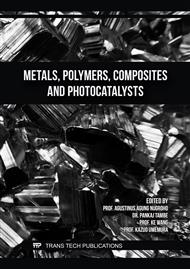p.3
p.9
p.15
p.23
p.29
p.41
p.57
p.71
Preparation and Supercapacitive Performance of ZIF-67 Composite Materials Modified with Polydopamine
Abstract:
ZIF-67 was synthesized using conventional solution method and PDA/ZIF-67 composites with various addition mass ratio were prepared through self-polymerizing dopamine hydrochloride to form polydopamine (PDA) coating on the surface of ZIF-67 at room temperature by utilizing the strong adhesion property of polydopamine. The structure and morphology of the samples were characterized by SEM, XRD and FT-IR. The capacitive performances of prepared pure ZIF-67 and composites with different mass ratios were tested by CV and GCD in a three-electrode system. The findings confirmed the successful formation of PDA/ZIF-67 composites. In comparison to pristine ZIF-67, the PDA/ZIF-67 composites, when coated with an appropriate quantity of polydopamine, demonstrated improved capacitive performance. The optimal mass ratio for dopamine to ZIF-67 was determined to be 1:4, which yielded a higher specific capacitance of 648.8 F/g at a current density of 1 A/g, and the material also exhibited superior capacity retention after 4000 charge/discharge cycles at 15 A/g. These results indicated that the PDA/ZIF-67 composites synthesized with dopamine and ZIF-67 in an appropriate mass ratio has better energy storage and electrochemical stability than a single ZIF-67.
Info:
Periodical:
Pages:
3-8
Citation:
Online since:
May 2025
Authors:
Keywords:
Price:
Сopyright:
© 2025 Trans Tech Publications Ltd. All Rights Reserved
Share:
Citation:



